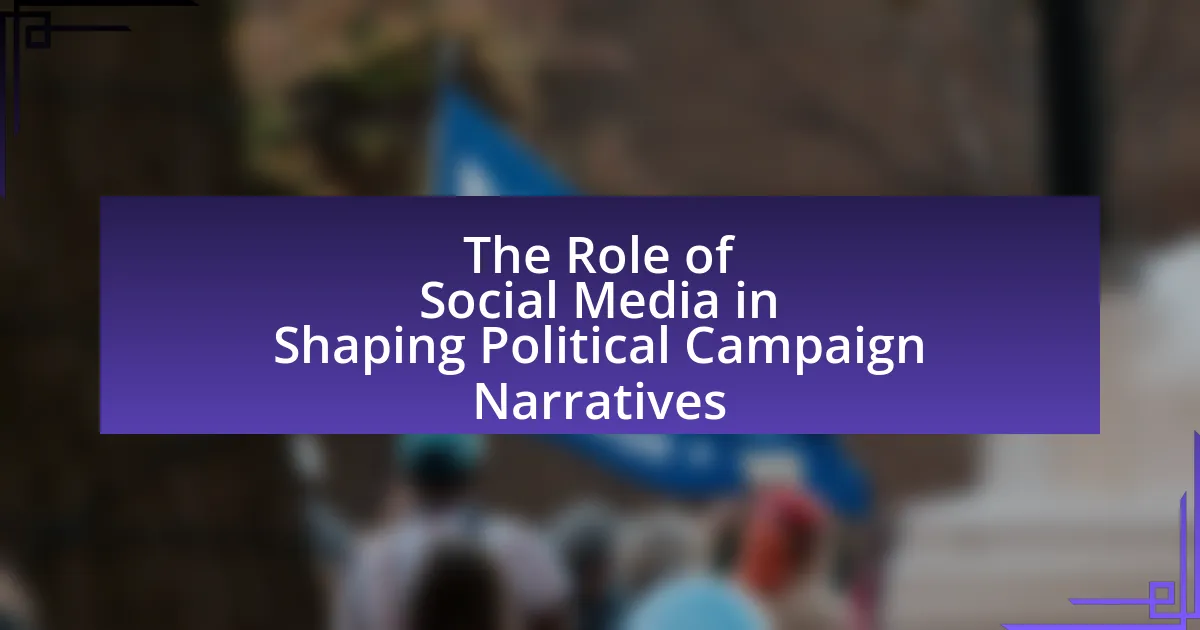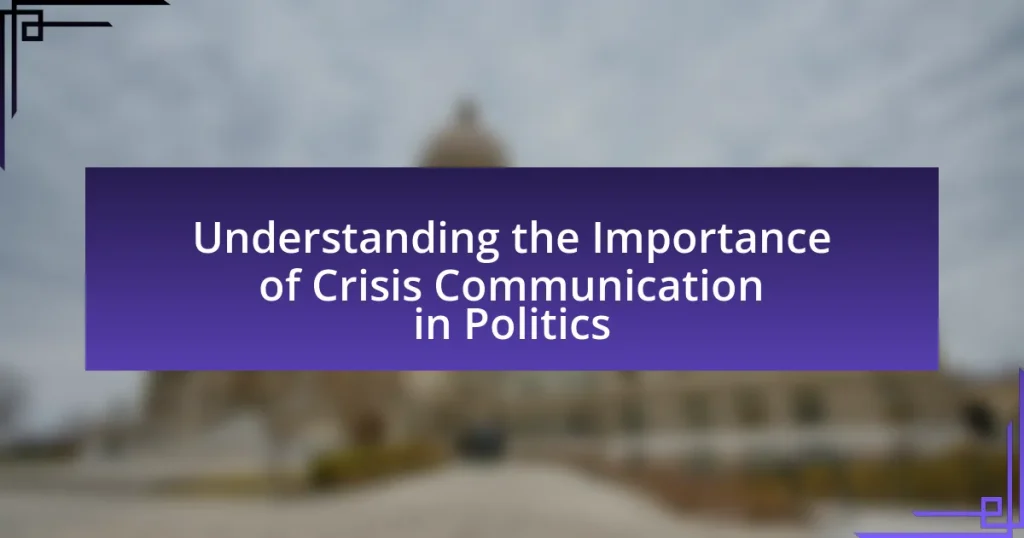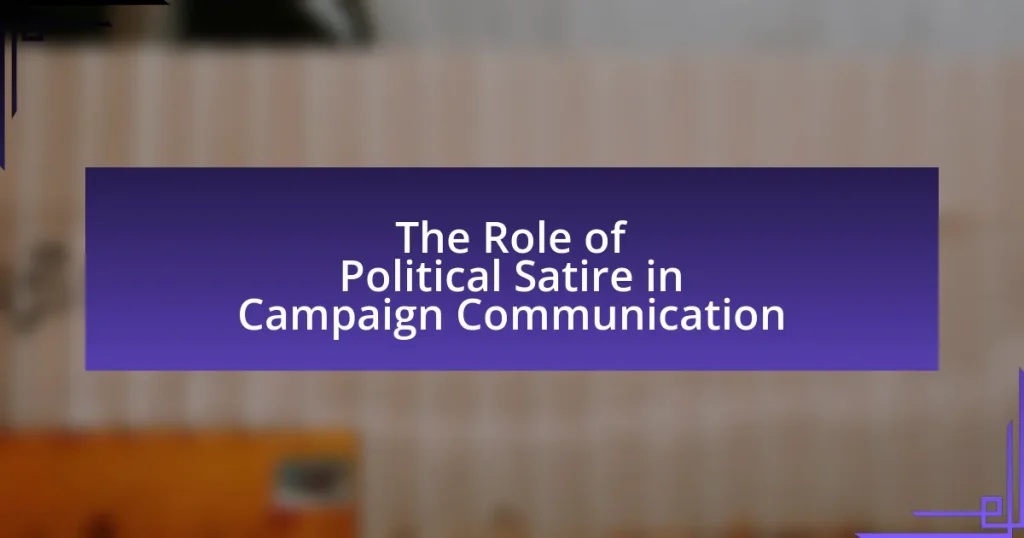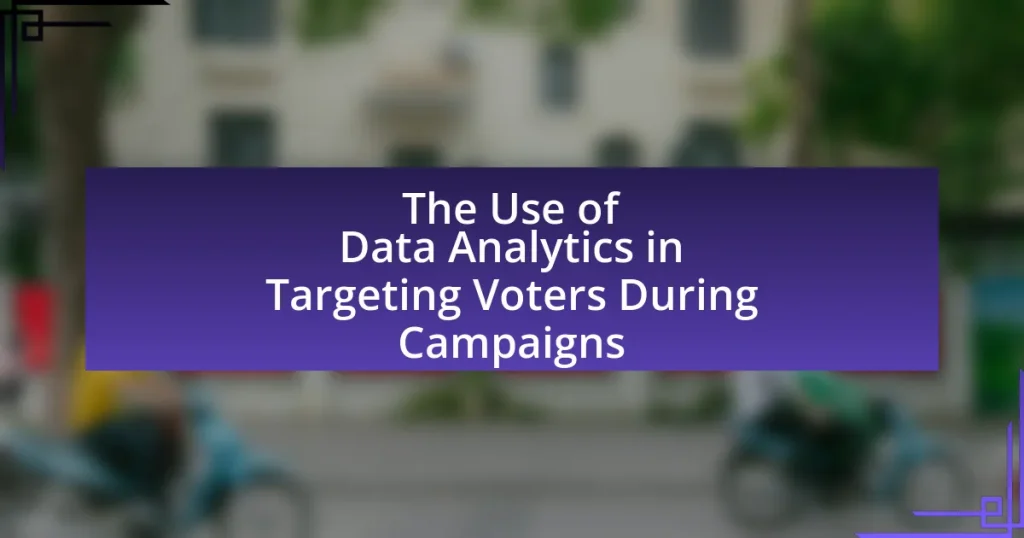The article examines the significant role of social media in shaping political campaign narratives, highlighting how platforms like Facebook, Twitter, and Instagram facilitate direct communication between candidates and voters. It discusses the transformation of political communication through real-time information dissemination, targeted messaging, and the engagement of different demographics. Key challenges such as misinformation and algorithm changes are addressed, along with the ethical considerations of political advertising. The article also explores strategies for effective social media use in campaigns, including content creation, audience engagement, and performance measurement, ultimately emphasizing the profound impact of social media on political narratives and election outcomes.
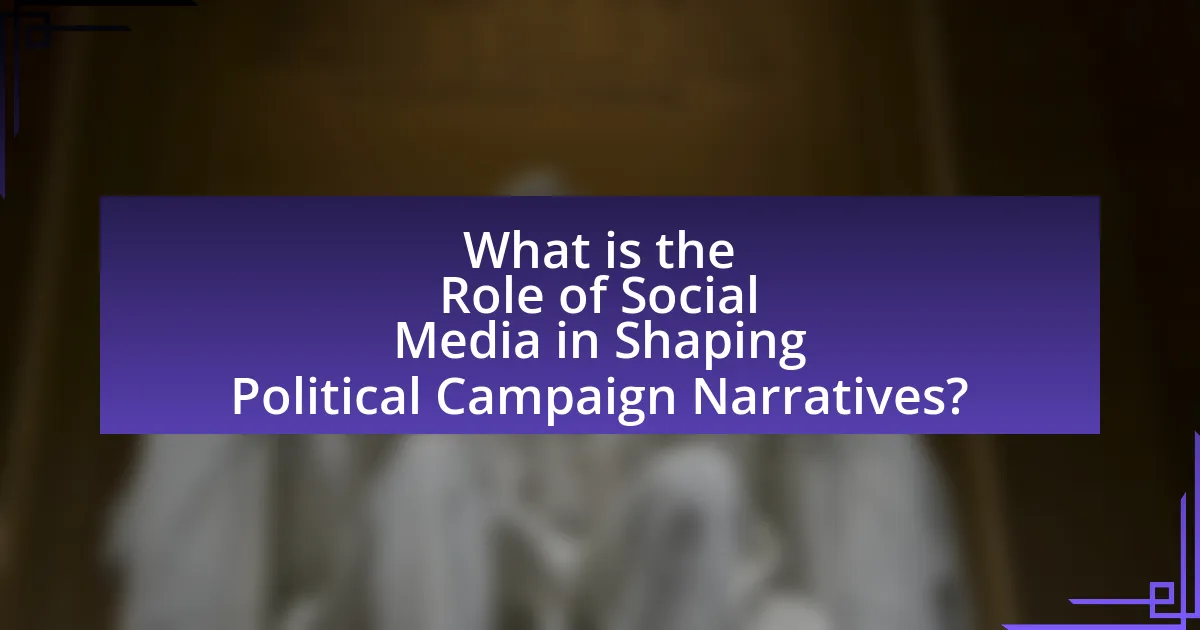
What is the Role of Social Media in Shaping Political Campaign Narratives?
Social media plays a crucial role in shaping political campaign narratives by providing platforms for direct communication between candidates and voters. This direct interaction allows candidates to craft and disseminate their messages quickly, bypassing traditional media filters. For instance, during the 2016 U.S. presidential election, Donald Trump utilized Twitter to communicate his views and rally support, which significantly influenced public perception and media coverage. Additionally, social media enables the rapid spread of information, including campaign advertisements and grassroots movements, which can mobilize voters and create viral narratives. Research indicates that social media platforms can amplify political messages, with studies showing that tweets from candidates can lead to increased engagement and voter turnout.
How has social media transformed political communication?
Social media has transformed political communication by enabling direct interaction between politicians and the public, facilitating real-time information dissemination, and allowing for targeted messaging. This shift has led to a more engaged electorate, as platforms like Twitter and Facebook allow candidates to communicate their messages instantly and respond to public sentiment quickly. For instance, during the 2008 U.S. presidential election, Barack Obama’s campaign effectively utilized social media to mobilize voters, resulting in a significant increase in voter turnout among younger demographics. This demonstrates how social media not only changes the way political messages are conveyed but also influences voter behavior and engagement in the political process.
What are the key platforms influencing political narratives?
Key platforms influencing political narratives include Facebook, Twitter, Instagram, and YouTube. These platforms serve as primary channels for political communication, enabling politicians and parties to disseminate messages directly to the public. For instance, Facebook’s user base exceeds 2.8 billion monthly active users, making it a significant tool for targeted political advertising and grassroots mobilization. Twitter, with its real-time information sharing, has become essential for political discourse, allowing rapid responses to events and shaping public opinion. Instagram’s visual content appeals to younger demographics, influencing their political engagement. YouTube, as a video-sharing platform, facilitates the spread of political content through vlogs, debates, and campaign ads, reaching diverse audiences. Collectively, these platforms shape political narratives by influencing public perception and engagement in the political process.
How do different demographics engage with political content on social media?
Different demographics engage with political content on social media in distinct ways, influenced by factors such as age, education, and political affiliation. For instance, younger users, particularly those aged 18-29, are more likely to consume and share political content on platforms like Instagram and TikTok, with 50% of this age group reporting that social media is their primary source of political news, according to the Pew Research Center. In contrast, older demographics, such as those aged 50 and above, tend to prefer Facebook for political engagement, often sharing articles and participating in discussions, with 60% of older adults indicating that they use social media to stay informed about political issues. Additionally, individuals with higher education levels are more likely to engage critically with political content, often participating in discussions and sharing fact-checked information, while those with lower educational attainment may engage more passively, primarily consuming content without active participation. This variation in engagement reflects broader trends in media consumption and political participation across different demographic groups.
Why is social media important in modern political campaigns?
Social media is important in modern political campaigns because it enables direct communication between candidates and voters, facilitating engagement and mobilization. This platform allows candidates to share their messages instantly, reach a broader audience, and respond to public sentiment in real-time. For instance, during the 2020 U.S. presidential election, candidates utilized social media to engage millions of users, with platforms like Twitter and Facebook playing crucial roles in shaping public discourse and influencing voter opinions. According to a Pew Research Center study, 69% of adults in the U.S. reported using social media, highlighting its significance as a tool for political outreach and information dissemination.
What advantages does social media offer to political candidates?
Social media offers political candidates the advantage of direct communication with voters, enabling them to disseminate their messages quickly and efficiently. This platform allows candidates to engage with their audience in real-time, fostering a sense of connection and immediacy that traditional media cannot match. For instance, during the 2020 U.S. presidential election, candidates utilized platforms like Twitter and Facebook to reach millions of voters instantly, with Joe Biden’s campaign reportedly spending over $100 million on social media ads to target specific demographics. Additionally, social media facilitates grassroots organizing, allowing candidates to mobilize supporters and encourage participation in campaigns and events. This capability is evidenced by the success of movements like Bernie Sanders’ campaign, which effectively used social media to build a large, engaged following.
How does social media facilitate voter engagement and mobilization?
Social media facilitates voter engagement and mobilization by providing platforms for direct communication between candidates and voters, enabling real-time information sharing and community building. These platforms allow political campaigns to reach a broader audience quickly, as evidenced by the 2020 U.S. presidential election, where 73% of voters reported using social media to engage with political content. Additionally, social media encourages grassroots organizing, as seen in movements like Black Lives Matter, which utilized platforms to mobilize supporters for protests and voter registration drives. This direct interaction fosters a sense of community and urgency, motivating individuals to participate in the electoral process.
What challenges do political campaigns face on social media?
Political campaigns face several challenges on social media, including misinformation, platform algorithm changes, and audience engagement. Misinformation can spread rapidly, undermining campaign messages and creating confusion among voters; for instance, during the 2020 U.S. presidential election, false information about candidates circulated widely on platforms like Facebook and Twitter. Additionally, frequent changes in social media algorithms can affect the visibility of campaign content, making it difficult for campaigns to reach their target audiences effectively. Lastly, engaging users in meaningful conversations is challenging due to the oversaturation of content, which can lead to decreased interaction rates; studies show that engagement rates for political posts can be significantly lower than for other types of content.
How do misinformation and fake news impact political narratives?
Misinformation and fake news significantly distort political narratives by shaping public perception and influencing voter behavior. These falsehoods can create confusion, polarize opinions, and undermine trust in legitimate news sources. For instance, a study by the Pew Research Center found that 64% of Americans believe fabricated news stories cause a great deal of confusion about the basic facts of current events. This manipulation of information can lead to the reinforcement of biases, as individuals are more likely to share content that aligns with their pre-existing beliefs, further entrenching divisive narratives.
What are the ethical considerations for political advertising on social media?
The ethical considerations for political advertising on social media include transparency, misinformation, and targeting practices. Transparency requires that political ads clearly disclose their sponsors, allowing users to understand who is behind the message. Misinformation poses a significant risk, as false claims can spread rapidly, influencing public opinion and undermining democratic processes. Targeting practices raise ethical concerns regarding the manipulation of vulnerable populations through tailored messaging, which can exploit personal data without consent. These considerations are crucial for maintaining integrity in political discourse and ensuring that social media platforms do not facilitate harmful practices that could distort electoral outcomes.
How do political campaigns effectively utilize social media?
Political campaigns effectively utilize social media by engaging directly with voters, disseminating information rapidly, and targeting specific demographics. Campaigns leverage platforms like Facebook, Twitter, and Instagram to create tailored content that resonates with different audience segments, enhancing voter outreach. For instance, during the 2020 U.S. presidential election, Joe Biden’s campaign utilized targeted ads on social media, reaching over 100 million users, which significantly contributed to voter mobilization. Additionally, social media allows for real-time interaction, enabling campaigns to respond to public sentiment and news events swiftly, thus shaping narratives and influencing voter perceptions effectively.
What strategies can candidates employ to enhance their online presence?
Candidates can enhance their online presence by actively engaging with their audience on social media platforms. This includes regularly posting relevant content, responding to comments, and participating in discussions to build a community around their campaign. Research indicates that candidates who utilize social media effectively can increase voter engagement; for instance, a study by the Pew Research Center found that 69% of adults in the U.S. use social media, making it a vital tool for outreach. Additionally, candidates should leverage targeted advertising to reach specific demographics, as data shows that tailored ads can significantly improve campaign visibility and voter turnout.
How can campaigns measure the effectiveness of their social media efforts?
Campaigns can measure the effectiveness of their social media efforts through key performance indicators (KPIs) such as engagement rates, reach, conversion rates, and sentiment analysis. Engagement rates, which include likes, shares, and comments, indicate how well the audience interacts with the content. Reach measures the total number of unique users who see the posts, providing insight into the campaign’s visibility. Conversion rates track the percentage of users who take a desired action, such as signing up for a newsletter or donating, reflecting the campaign’s ability to drive action. Sentiment analysis evaluates the public’s emotional response to the campaign, helping to gauge overall perception. These metrics collectively provide a comprehensive view of social media effectiveness, allowing campaigns to adjust strategies based on data-driven insights.
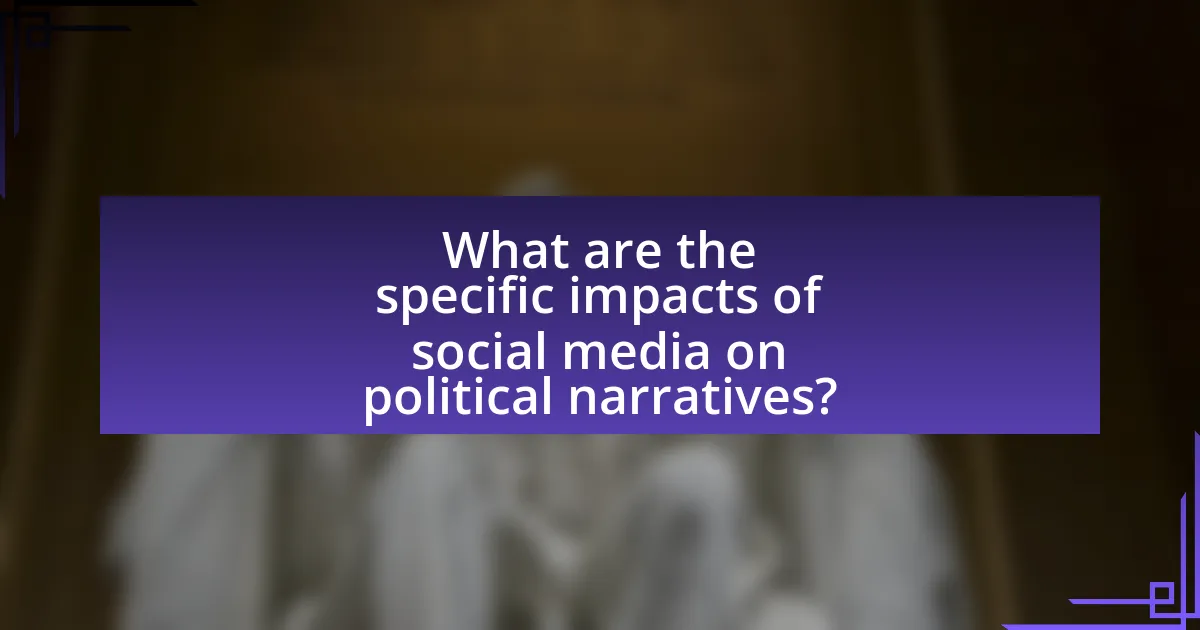
What are the specific impacts of social media on political narratives?
Social media significantly impacts political narratives by enabling rapid dissemination of information, shaping public opinion, and facilitating direct engagement between politicians and constituents. The immediacy of platforms like Twitter and Facebook allows political messages to reach large audiences quickly, influencing perceptions and reactions in real-time. For instance, during the 2016 U.S. presidential election, social media was pivotal in spreading both campaign messages and misinformation, with studies indicating that false news stories were shared more widely than factual ones. Additionally, social media fosters echo chambers, where users are exposed primarily to viewpoints that reinforce their beliefs, further polarizing political discourse. This dynamic alters traditional media’s role, as social media often dictates the narratives that mainstream outlets cover, thereby reshaping the overall political landscape.
How does social media influence public perception of candidates?
Social media significantly influences public perception of candidates by shaping narratives and facilitating direct communication between candidates and voters. Through platforms like Twitter and Facebook, candidates can share their messages, respond to criticism, and engage with supporters in real-time, which can enhance their relatability and visibility. Research indicates that 69% of adults in the U.S. use social media, making it a crucial tool for candidates to reach a broad audience. Additionally, social media algorithms often prioritize content that generates engagement, which can amplify certain narratives, whether positive or negative, about candidates. This dynamic can lead to the rapid spread of misinformation or biased portrayals, further impacting how candidates are perceived by the public.
What role do influencers play in shaping political opinions on social media?
Influencers play a significant role in shaping political opinions on social media by leveraging their large followings to disseminate information and perspectives that can sway public sentiment. Their ability to engage audiences through relatable content and personal narratives allows them to frame political issues in ways that resonate with their followers. For instance, a study by the Pew Research Center found that 70% of social media users have encountered political content shared by influencers, indicating their substantial reach and impact. Additionally, influencers often act as intermediaries between political entities and the public, translating complex political messages into more digestible formats, which can enhance understanding and engagement among their audience.
How do viral trends affect political messaging?
Viral trends significantly influence political messaging by amplifying specific narratives and shaping public perception. When a trend goes viral, it often captures widespread attention, allowing political messages that align with the trend to reach a larger audience quickly. For instance, during the 2020 U.S. presidential election, memes and hashtags related to candidates became pivotal in framing their public images, as seen with the viral “OK Boomer” meme that resonated with younger voters and highlighted generational divides. This phenomenon demonstrates how viral content can dictate the themes and tone of political discourse, compelling candidates to adapt their messaging strategies to engage effectively with the trending topics.
What are the implications of social media narratives on election outcomes?
Social media narratives significantly influence election outcomes by shaping public perception and voter behavior. These platforms enable rapid dissemination of information, allowing candidates to communicate directly with voters and bypass traditional media filters. For instance, during the 2016 U.S. presidential election, research indicated that 62% of Americans obtained their news from social media, highlighting its role in informing voter opinions. Furthermore, targeted advertising and algorithm-driven content can amplify specific narratives, swaying undecided voters and reinforcing existing biases. Studies, such as those conducted by the Pew Research Center, demonstrate that social media can create echo chambers, where users are exposed primarily to viewpoints that align with their own, further polarizing the electorate. Thus, the implications of social media narratives are profound, as they can alter the dynamics of political engagement and ultimately affect election results.
How can social media sway undecided voters?
Social media can sway undecided voters by amplifying targeted political messaging and facilitating peer influence. Platforms like Facebook and Twitter allow campaigns to tailor advertisements based on user data, reaching specific demographics with messages that resonate with their values and concerns. Research from the Pew Research Center indicates that 69% of adults in the U.S. use social media, making it a powerful tool for engagement. Additionally, social media fosters discussions among users, where opinions can be shaped by friends and influencers, creating a bandwagon effect that can lead to shifts in voter preferences.
What case studies illustrate the impact of social media on recent elections?
Case studies illustrating the impact of social media on recent elections include the 2016 U.S. Presidential Election and the 2019 Indian General Election. In the 2016 U.S. Presidential Election, social media platforms like Facebook and Twitter played a crucial role in shaping voter perceptions and mobilizing support, with over 60% of voters reporting that social media influenced their voting decisions. The Cambridge Analytica scandal highlighted how targeted ads and data analytics were used to sway public opinion. In the 2019 Indian General Election, political parties utilized WhatsApp extensively to disseminate information and misinformation, reaching millions of voters; a study indicated that 90% of Indian voters used social media for political information, significantly impacting voter engagement and turnout. These case studies demonstrate the transformative role of social media in modern electoral processes.
How do political narratives evolve on social media platforms?
Political narratives evolve on social media platforms through dynamic interactions among users, content sharing, and algorithmic amplification. These platforms facilitate rapid dissemination of information, allowing narratives to shift based on user engagement and trending topics. For instance, during the 2016 U.S. presidential election, social media played a crucial role in shaping public perception, with narratives often changing in response to viral posts or trending hashtags. Research by the Pew Research Center indicates that 62% of Americans get news from social media, highlighting its influence on political discourse. This evolution is further driven by the ability of users to create and share content, leading to grassroots movements that can challenge or reinforce existing narratives.
What factors contribute to the rapid change of narratives during campaigns?
Rapid changes in narratives during campaigns are primarily driven by the immediacy and reach of social media platforms. Social media allows for real-time dissemination of information, enabling rapid responses to events, statements, or controversies. For instance, during the 2016 U.S. presidential election, Twitter was instrumental in shaping narratives, as candidates and their supporters could quickly react to news and opponent statements, often leading to shifts in public perception within hours. Additionally, algorithms on these platforms prioritize engagement, which can amplify sensational or polarizing content, further accelerating narrative changes. This dynamic environment fosters a cycle where narratives can evolve or be completely reshaped based on trending topics, user interactions, and media coverage, illustrating the significant impact of social media on political discourse.
How do campaigns adapt their messaging in response to social media feedback?
Campaigns adapt their messaging in response to social media feedback by analyzing audience reactions and engagement metrics to refine their communication strategies. For instance, when a campaign receives negative feedback on a specific message, it may pivot to emphasize different themes or adjust the tone to better resonate with voters. Research indicates that 70% of political campaigns actively monitor social media sentiment to inform their messaging decisions, allowing them to respond quickly to public concerns and preferences. This responsiveness not only enhances voter engagement but also helps in mitigating potential backlash, demonstrating the significant impact of social media feedback on campaign narratives.
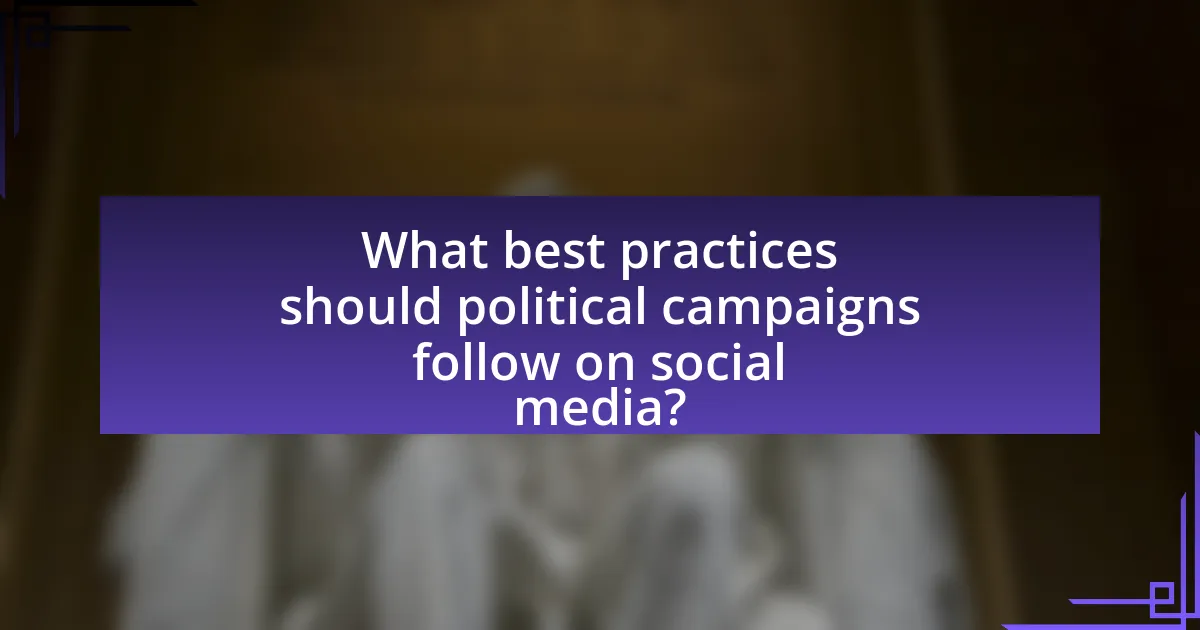
What best practices should political campaigns follow on social media?
Political campaigns should prioritize authenticity, engagement, and targeted messaging on social media. Authenticity builds trust with voters, as campaigns that present genuine content are more likely to resonate with audiences. Engagement is crucial; campaigns should actively respond to comments and messages to foster a sense of community and connection. Targeted messaging ensures that content reaches the appropriate demographics, maximizing impact. According to a study by the Pew Research Center, 69% of adults in the U.S. use social media, making it an essential platform for reaching potential voters. Additionally, campaigns that utilize data analytics to tailor their messages can increase voter engagement and turnout, as evidenced by the success of the Obama campaign in 2008, which effectively used social media to mobilize supporters.
How can campaigns create authentic and engaging content?
Campaigns can create authentic and engaging content by leveraging storytelling that resonates with their target audience’s values and experiences. This approach fosters a genuine connection, as research indicates that narratives can significantly enhance emotional engagement, leading to increased voter interest and participation. For instance, a study by the Pew Research Center found that 69% of social media users engage with political content that reflects their personal beliefs and experiences, highlighting the importance of relatability in content creation. By utilizing real stories, testimonials, and interactive elements, campaigns can effectively capture attention and encourage meaningful dialogue among constituents.
What types of content resonate most with voters on social media?
Visual content, particularly videos and infographics, resonates most with voters on social media. Research indicates that posts featuring videos receive 1200% more shares than text and images combined, highlighting their effectiveness in engaging audiences. Additionally, emotionally charged content, such as personal stories and testimonials, tends to foster a stronger connection with voters, as it humanizes political messages and encourages empathy. A study by the Pew Research Center found that 64% of voters are more likely to engage with content that evokes strong emotions, further supporting the idea that visual and emotionally resonant content is key to voter engagement on social media platforms.
How can campaigns effectively respond to criticism and negative feedback?
Campaigns can effectively respond to criticism and negative feedback by actively engaging with the audience, acknowledging concerns, and providing transparent communication. Engaging with critics through social media platforms allows campaigns to address issues directly, demonstrating responsiveness and accountability. Acknowledging concerns shows that the campaign values feedback, which can help to mitigate negative perceptions. For instance, a study by the Pew Research Center found that 64% of social media users believe that politicians should respond to criticism online, indicating that direct engagement can enhance public trust. Transparent communication, including clarifying misinformation and outlining corrective actions, further reinforces the campaign’s commitment to integrity and responsiveness.
What tools and resources are available for managing social media in political campaigns?
Social media management tools for political campaigns include Hootsuite, Buffer, and Sprout Social, which facilitate scheduling, analytics, and engagement across multiple platforms. Hootsuite allows users to monitor social media channels in one place, providing insights into audience engagement and campaign performance. Buffer offers scheduling capabilities and performance analytics, enabling campaigns to optimize posting times and content strategies. Sprout Social provides comprehensive reporting features and social listening tools, helping campaigns understand public sentiment and adjust messaging accordingly. These tools are essential for effectively managing online presence and responding to real-time events during campaigns.
Which analytics tools can help campaigns track their social media performance?
Google Analytics, Hootsuite, Sprout Social, and Buffer are analytics tools that can help campaigns track their social media performance. Google Analytics provides insights into website traffic driven by social media, allowing campaigns to measure conversion rates and user behavior. Hootsuite offers comprehensive social media management and analytics, enabling users to track engagement metrics across multiple platforms. Sprout Social provides detailed reporting on audience engagement and post-performance, helping campaigns refine their strategies. Buffer allows users to analyze post performance and audience interactions, facilitating data-driven decision-making. These tools collectively enhance the ability of campaigns to assess and optimize their social media efforts effectively.
How can campaigns leverage social media advertising effectively?
Campaigns can leverage social media advertising effectively by targeting specific demographics and utilizing data analytics to optimize ad performance. By analyzing user behavior and preferences, campaigns can create tailored content that resonates with their audience, leading to higher engagement rates. For instance, a study by the Pew Research Center found that 69% of adults in the U.S. use Facebook, making it a prime platform for targeted advertising. Additionally, campaigns can employ A/B testing to refine their messaging and visuals, ensuring that they maximize their reach and impact. This strategic approach not only enhances visibility but also fosters a more engaged voter base, ultimately influencing political narratives.
What are the common pitfalls to avoid in social media political campaigns?
Common pitfalls to avoid in social media political campaigns include neglecting audience engagement, spreading misinformation, and failing to adapt to platform-specific norms. Neglecting audience engagement can lead to a disconnect between the campaign and potential voters, as studies show that interactive content increases voter interest and participation. Spreading misinformation can damage credibility and trust; for instance, a 2020 study by the Pew Research Center found that 64% of Americans believe misinformation has a significant impact on political discourse. Lastly, failing to adapt to platform-specific norms can result in ineffective messaging; different social media platforms have unique user demographics and content styles, which require tailored approaches for successful outreach.
How can campaigns prevent backlash from poorly executed social media strategies?
Campaigns can prevent backlash from poorly executed social media strategies by implementing thorough planning and real-time monitoring. Effective planning involves setting clear objectives, understanding the target audience, and crafting messages that resonate with them. For instance, a study by the Pew Research Center indicates that 69% of adults in the U.S. use social media, highlighting the importance of tailored content that aligns with audience preferences. Real-time monitoring allows campaigns to quickly identify and address negative feedback or miscommunications, as demonstrated by the swift response of brands like Wendy’s during social media crises, which mitigated potential backlash. By combining strategic planning with proactive engagement, campaigns can significantly reduce the risk of negative repercussions from their social media efforts.
What lessons can be learned from unsuccessful social media campaigns?
Unsuccessful social media campaigns reveal critical lessons about audience engagement, message clarity, and platform appropriateness. Firstly, campaigns often fail when they do not resonate with their target audience, highlighting the importance of thorough audience research and segmentation. For instance, the 2016 #McDStories campaign backfired when users shared negative experiences instead of positive stories, demonstrating the need for understanding audience sentiment. Secondly, unclear messaging can lead to confusion and misinterpretation, as seen in the 2017 Pepsi ad featuring Kendall Jenner, which faced backlash for trivializing social justice movements. This underscores the necessity of crafting messages that align with the values and expectations of the audience. Lastly, selecting the right platform is crucial; campaigns that do not consider the unique characteristics and user demographics of each social media platform may struggle to gain traction. For example, a campaign aimed at younger voters may perform poorly on Facebook compared to platforms like TikTok or Instagram. These lessons emphasize the importance of strategic planning, audience insight, and message alignment in social media campaigns.
